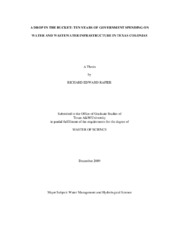| dc.contributor.advisor | Kaiser, Ronald A. | |
| dc.creator | Rapier, Richard Edward | |
| dc.date.accessioned | 2011-02-22T22:23:55Z | |
| dc.date.accessioned | 2011-02-22T23:46:36Z | |
| dc.date.available | 2011-02-22T22:23:55Z | |
| dc.date.available | 2011-02-22T23:46:36Z | |
| dc.date.created | 2009-12 | |
| dc.date.issued | 2011-02-22 | |
| dc.date.submitted | December 2009 | |
| dc.identifier.uri | https://hdl.handle.net/1969.1/ETD-TAMU-2009-12-7440 | |
| dc.description.abstract | Since 1989, the United States Federal Government and the State of Texas have targeted water and wastewater infrastructure development spending in the colonias to improve access to safe, reliable and adequate water supplies and wastewater service. Prior to widespread installation of piped, treated water infrastructure, waterborne illnesses attained levels only seen in developing countries. Despite the hundreds of millions of dollars that have been spent since 1989 on water and wastewater infrastructure improvements, roughly a quarter of colonias still lacked basic access to water and wastewater services. Previous research and assessments of where this government spending has been targeted have not evaluated all four largest funding sources together or demonstrated the impacts of water and wastewater infrastructure spending on either public health or the local economy. This report evaluates the first of these problems by analyzing government spending of these funding sources from 1996 to 2006 in Cameron, Hidalgo, and Starr counties.
The report provides the history and context of the Texas colonia problem, discusses who provides water and wastewater services to the colonias, and describes the make-up of federal and state financial assistance to the colonias to develop their water and wastewater infrastructure. Conventional understandings of where government spending is going, for what, and to whom, are challenged by the data and analysis. Analysis results indicate greater spending on wastewater infrastructure improvements than water service in addition to greater allocation to municipal systems that extended service into colonia areas historically operated by water service corporations. Further research may build on this data as well as regional economic and epidemiological data to determine outcomes of the spending in quantitative terms using various impact assessment methodologies. This report concludes with a discussion of impact assessment. | en |
| dc.format.mimetype | application/pdf | |
| dc.language.iso | en_US | |
| dc.subject | Colonias | en |
| dc.subject | Texas | en |
| dc.subject | Water and Wastewater Infrastructure | en |
| dc.subject | Government Financial Assistance. | en |
| dc.title | A Drop in the Bucket: Ten Years of Government Spending on Water and Wastewater Infrastructure in Texas Colonias | en |
| dc.type | Book | en |
| dc.type | Thesis | en |
| thesis.degree.department | Recreation, Park, and Tourism Sciences | en |
| thesis.degree.discipline | Water Management and Hydrological Science | en |
| thesis.degree.grantor | Texas A&M University | en |
| thesis.degree.name | Master of Science | en |
| thesis.degree.level | Masters | en |
| dc.contributor.committeeMember | Brumbelow, Kelly | |
| dc.contributor.committeeMember | Giardino, John "Rick" R. | |
| dc.type.genre | Electronic Thesis | en |
| dc.type.material | text | en |


